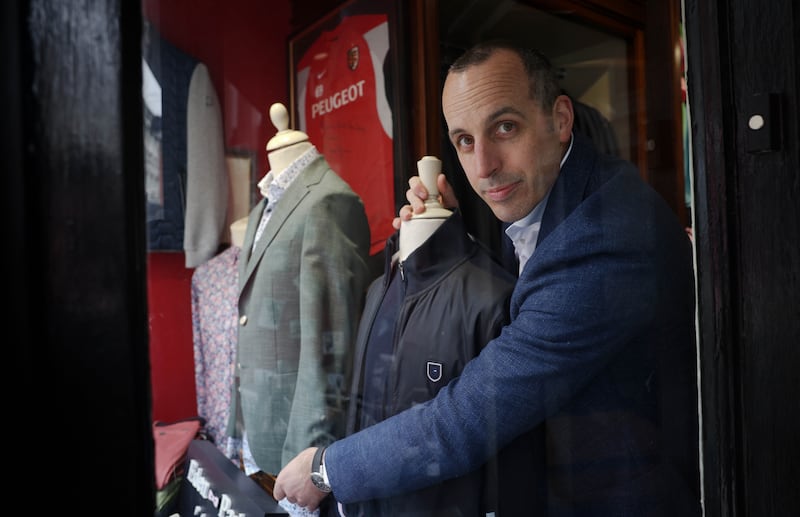It started with dress-down Friday, when office workers ditched their suits and ties for jeans and T-shirts. Then the bosses of the tech companies created a trend for CEOs dressing casually – Steve Jobs in black turtlenecks and Mark Zuckerberg in hoodies. You no longer had to wear a suit to show you meant business.
In 2019, as offices became more and more informal, Goldman Sachs told its staff to dress in a manner consistent with client expectation. Then Covid struck, and the business suit went the way of the business card. One of the few people prepared to be seen in one was the cage fighter Conor McGregor.
So what has all this meant for traditional tailors, with their tapes, scissors and thread? Have they been folding like, well, a cheap suit?
“There was already a trend against suits, but Covid accelerated it no end, and it hasn’t righted itself. It’s jaw-dropping, the pace of change. So yes, it certainly hurt businesses like ourselves,” says Mark Dinneen of John Taylor Menswear, a small family company that has been trading on Baggot Street in Dublin for the last 50 years.
READ MORE

“The game was up if you were just selling business suits. We had to reinvent our business, switch it all around – change all the lighting, and the flooring. The casual wear programme had to be hugely enhanced, and the store had to have a makeover to make sure that casual wear looked the way it should be.”
Dinneen estimates that business suits went from about 40 per cent of his trade to less than 1 per cent during Covid, “and it’s still less than 5 per cent now”.
Frewen & Aylward, which has been in business in Dún Laoghaire for 60 years, has also redesigned its store in order to highlight semi-casual wear. Richard Farrell, the manager, points out that neckties and leather shoes, the other mainstays of menswear shops, have also become fashion victims.
“The first three days after Christmas every year used to be about guys coming in stocking up on suits,” says Farrell. “Even before Covid, guys were wearing suits with open-neck shirts with a bit of detail on the collar. But if you went into a restaurant now with a suit and tie, they would look at you and wonder what’s wrong.
“Our business now is more chinos, and smart casual shirts. We are also selling more shorts than we ever did – because of guys working from home.”
The pinstripes and checks are gone. You don’t see any world leaders in a big check suit. It’s more the George Clooney look. A two-piece suit is simple and more effective than the more aggressive look
— Paddy Sheary, Patrick Sheary Menswear
Even the job of a men’s tailor has changed, according to Farrell. These days it’s more about helping customers to match up jackets with chinos and pullovers. “We had to reinvent completely. We had to get used to selling outfits rather than a guy buying a suit,” he says. “We had to change our whole buying policy as well.”
Paddy Sheary of Patrick Sheary Menswear on Clarendon Street in Dublin city centre also recalls the biannual visits of office workers stocking up on business suits. “In January and September, you would always get a hit – guys going back to work after the summer holidays and they need two or three suits. That does not really happen any more,” he says. “Of my sales last year, 80 per cent were occasion-driven.”

Sheary says the typical customer now buys a suit that will double up for many occasions – court appearances as well as christenings, weddings and funerals.
“In the past a customer might have bought three suits; now they buy one, with two pairs of trousers, and keep one pair for good wear,” he explains. “They don’t see the need for a business suit. So they get one that will cover a multitude of purposes, and get more functionality out of it.”
He reckons some professionals who wear smart casual to work do keep a suit in a bag in a wardrobe at the office, in case they meet a client. The business suits he does sell tend to be in plain, low-key designs. “The pinstripes and checks are gone. You don’t see any world leaders in a big check suit. It’s more the George Clooney look. A two-piece suit is simple and more effective than the more aggressive look.”
Sheary no longer wears a suit to work himself, while Dinneen has ditched his lifetime habit of wearing a tie. “I had to give it up when we returned from lockdown. It just looked too over-the-top,” he explains. “I’m meeting people in shorts and flip-flops. Meeting them in a tie was overdoing it.”
If a groom comes in, the shop has a possibility of selling five suits, five shirts, and five pairs of shoes. If you can get one or two weddings a week, you can build a business around that
— Jonathan Gosson, Gosson Agencies Limited
Taking up the slack for menswear retailers is the surge in demand for wedding suits. Jonathan Gosson, owner of Gosson Agencies Limited and agents for Benetti and Skopes, specialises in weddings, and said last year was his busiest ever. About 20,000 weddings take place every year in Ireland, but that slipped to about 9,200 in the first year of Covid. Gosson reckons there were more than 30,000 weddings last year, due to the pent-up demand post pandemic.
“At the weddings, you now have day two, which is massive for formal dress as well,” he said. “On the wedding day, you wear a suit, and you are looking forward to that because you don’t normally dress up any more. Day two is normally another affair in a beer garden, or a pub with music, and guys are wearing dressy jackets and chinos. So the retailer is getting a double hit, and it’s very good for business if you are set up for it.”
Gosson points out that some international retailers have either reduced stocks of business suits, or stopped selling them, with some of the UK multiples leaving the Irish market entirely. “Ironically, that has driven the Irish public back to private independent stores, because they have nowhere else to get suits for their weddings,” he says.

In a further boost to retailers, renting suits has gone out of fashion, Gosson reveals, while the number of groomsmen at weddings has steadily increased. “So if a groom comes in, the shop has a possibility of selling five suits, five shirts, and five pairs of shoes. If you can get one or two weddings a week, you can build a business around that,” he says.
“The success of the Groom’s Room at Diffney [on Mary Street in Dublin] shows the strength of that market. You have to make an appointment there now. It’s been so successful they have opened up a second floor. As the old-timers in the trade would say, if you’re not in the wedding business you’re not in the suit business.”
Fashion is fickle, he points out, and maybe business suits will eventually stage a comeback. Maybe they already are. “Next year they might come back a bit,” predicts Richard Farrell of Frewen & Aylward. “It’s started in London, coming back slowly.”




















